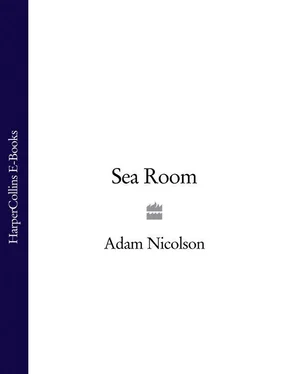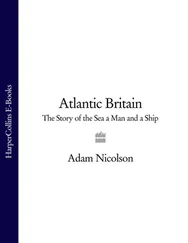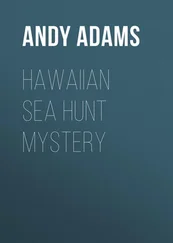1 ...8 9 10 12 13 14 ...21 The boat ran on into the bay. If the word ‘here’ has any meaning beyond simply the label of a place where you happen to be; if ‘here’ can be the name for the place to which you belong for more than just a moment, then this was my here. I let the anchor go and the chain ran out through the fairlead and down into the patch of sand, just off the Garbh Eilean screes where men have always anchored in a southwesterly. I unstepped the mast and folded the sail into its bag. I had arrived. I could hear the wind on the far side of the island beating without thought on the shore.
‘THE SEA WANTS TO BE VISITED’, a Gaelic proverb says and, as scarcely needs to be added, the host will murder its guests. Nothing can be understood about these islands, about the life that has been lived on them, and about the tensions under which people have existed here, without grasping that dual fact. The sea invites and the sea destroys. It is often said that the Hebrideans are not as natural seamen as the islanders in Orkney or Shetland, and that the northerners were fishermen who occasionally farmed and the Hebrideans farmers who occasionally fished. That isn’t entirely true, particularly in Lochs. In 1796, there were three hundred and sixty-six families. The ability of the ground itself to sustain the people was minimal. They were lucky if for every oat or grain of barley sown, they could harvest three or four.
Before the nineteenth-century Clearances, when the inhabitants of twenty-seven townships in Pairc were evicted, about three hundred of those Lochs families, distributed like limpets around the shore in their tiny hamlets, were dependent on fishing, mostly of cod and ling which were at their best between February and May. There were seventy fishing boats in Lochs, each with a crew of three or four. The Shiants would probably have had a single boat, or at most two, shared between the five families that lived here. The boats were, essentially, the same as my Freyja , although a little longer, twenty rather than sixteen feet, undecked, with six or eight oars, a heavy dipping lug rig and a hull made of pine (or larch for the better quality) on oak frames. The timber would have been imported, as it was for Freyja , from the mainland.
They can be horribly dangerous in a rising sea, when large volumes of water can land inboard without warning, and I know what would happen if a sea ever came into Freyja . Beside me in the stern I have a large bucket and I would start baling with that. I have watched myself in these situations: a kind of cold panic grips me, a terse rejection of terror. Of course it wouldn’t be enough. With the boat half full, Freyja would be riding lower than before. Almost certainly the next wave or the one after that would come in too. There would be no chance of keeping it out. The stern which John MacAulay had made for me, with that little sprung lift to its line, would not have the buoyancy. Within a minute or two the boat would be awash and there’s no baling then. That’s why the fishermen on Scalpay always ask me if I am going alone, why I am not taking anyone with me. Donald MacSween asks me every time: he smiles with the question, but not with his eyes. They say, ‘You don’t know what it will be like out there if something goes wrong. You would be safer with two.’ I know he thinks that, but he has never once said it.
I have seen one of these boats sunk before, in the warm, still conditions of a quiet bay in the Hebrides. It had been out of the water for a while, the wood had shrunk and when it was launched, the sea poured in like miniature Niagaras between the strakes on either side, rippling down step by step into a widening pool in the bilges. In half an hour she was down to her gunwales. I watched entranced as she went under. It was a blessing, not a catastrophe. I could feel the wood absorbing the water and it was like giving a thirsty animal a drink, a gulping at the longed-for element. The boat looked buried in the sea that morning. She no longer had an existence independent of the water, but sat there still and submerged as if in jelly, an embalming of her life, neither sinking nor floating but absorbed by the water from which she was usually so distinct.
That is a picture you see all around the Hebrides in the early spring, as men who have kept their boats ashore in the winter sink them for a week or so before the summer fishing. Each is tethered to its mooring in the loch like a cow in her paddock. She is happy there ingesting the goodness around her. The season of fatness is to hand and her belly is filling. It is an image of contentment but it is also a prefiguring of something worse: what happens to these small open boats when caught out in the wrong weather. They do not sink but they fill. The sea invades them. All weight in the boat must be thrown out if it is not to pull the hull down. I kept a knife beside me in the stern, ready to cut the rope which was holding down my belongings amidships so that once the hull filled I too could throw everything away. The sea, Donald MacSween told me, would soon turn the boat over and your only chance of survival was to hold onto that upturned hull. It is not easy. The little ledges formed by one strake overlapping the next do provide the thinnest of rock climbers’ footholds but the underwater profile is coated in the deliberately slimy Stockholm tar. As the weather worsens and the cold loosens your grip, the next big wave will wash you off into the sea. Then you are lost.
Records of boat losses are thin before 1800 but the nineteenth century in Lewis and Harris records again and again the loss of these boats and the drowning of their men. In February 1836, two boats from Point were caught out in a sudden gale. They were forced south before the wind, running for the Lochs coast at Cromore, just north of the Shiants. The crew of one boat survived. In the other, the four young men, inexperienced and perhaps underdressed, died of cold. Township after township lost their men. Year after year, boats went down from Barvas, Skigersta, in the district of Ness. In 1875 an oar was all that was found of a boat from Borve, coming ashore at Bragar. Two years later, a Bernera boat was lost with all its crew off the Flannans. Between 1862 and 1889, seventy fishermen from the district of Ness were drowned, in 1895, nineteen men from Back. Almost three hundred Lewis men were drowned in the second half of the nineteenth century, all of them within a few miles of their home shores, some of them watched by their families and friends as the small boats struggled to get home through the surf.
If the bodies came ashore, which they often didn’t, they, like the boats, were smashed into pieces or rotted beyond recognition. It was the pattern all down the western seaboard of the British Isles. Poor soils drive men to boats in which they drown.
At the Shiants themselves, in the spring of 1881 four young fishermen from the village of Lemreway in Lochs came out to the islands to catch a few puffins. None of them was more than twenty years old: Murdo Macmillan, Norman’s son; John Macinnes, Donald’s son; Angus Ferguson, Murdo’s son, and Donald Macdonald, Kenneth’s son. That’s how Dan Macleod, a retired merchant seaman, weaver, story-teller and the carrier of memories and traditions in Lemreway, described them to me. He tells the story in the way Hughie MacSween does, twisting his roll-up between his fingers, looking away to draw on the memory, looking at you to communicate it. Dan also gave me their addresses: the Macmillans lived at 1 Lemreway, the Fergusons at 3 Lemreway, the Macinneses at 5, the Macdonalds at 7. None of the boys was married. ‘They were young boys,’ Dan says. ‘And they wouldn’t be salting the puffins. They’d be giving them away.’
For several decades, probably since the beginning of the nineteenth century, the Lemreway men had come out to the Shiants in May and June to catch the puffins. In the 1850s, Osgood Mackenzie, then still a boy, but in time the creator of the subtropical gardens on his inherited estate at Inverewe, near Gairloch, on the mainland, came out to the Shiants and witnessed the Lemreway men catching the puffins: ‘They brought back boatloads of them because they valued the feathers,’ he wrote in his autobiography.
Читать дальше












